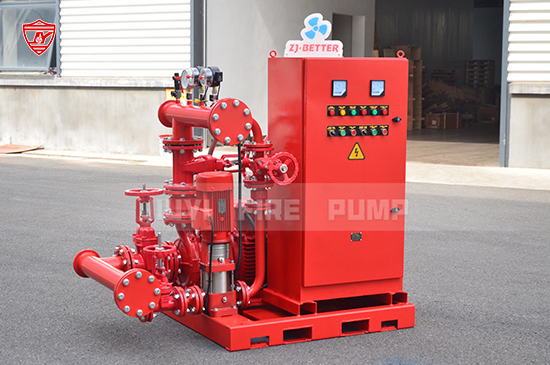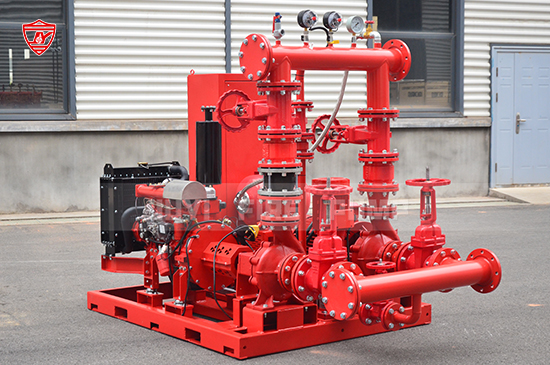In multi-zone buildings such as high-rise towers, hospitals, malls, and industrial complexes, fire protection is more complex than in low-rise structures. The design and selection of fire pumps in these settings are crucial for ensuring that each zone—whether on the first or fiftieth floor—receives adequate water pressure and flow during a fire emergency.
As a leading fire pump manufacturer, we understand that choosing the right fire pump for a multi-zone building is not just a matter of flow and pressure—it’s about designing a system that remains operational, compliant, and efficient under challenging conditions. This article explores key factors, industry standards, and selection strategies for fire pumps in multi-zone buildings.

A multi-zone building refers to any structure with vertical or horizontal divisions that require separate pressure zones due to significant elevation differences. This typically includes:
High-rise residential and commercial towers
Hospitals and medical centers
Multi-level shopping centers
Industrial facilities with varying elevation levels
These zones are created to manage the pressure differences in sprinkler and standpipe systems, since water pressure decreases as elevation increases.
Selecting fire pumps for multi-zone buildings involves addressing these critical challenges:
Pressure Zoning: Preventing over-pressurization in lower floors while maintaining sufficient pressure at the top.
Pressure Reducing Valves (PRVs): Required to manage pressure in lower zones but add system complexity.
Water Supply Reliability: Ensuring that the pump can supply the needed flow and pressure even in peak demand or failure scenarios.
Code Compliance: NFPA 20, NFPA 14, local fire codes, and insurance standards must all be met.
Begin by analyzing the building’s layout, height, usage type, and fire risk profile. Ask:
What is the building height?
How many pressure zones are needed?
Are there combined sprinkler and standpipe systems?
Are water storage tanks on-site or are you relying on municipal supply?
This will help define the flow demand (GPM) and total dynamic head (TDH)—the two fundamental parameters for pump selection.
Each zone will have a unique required flow rate, depending on:
Type of hazard (light, ordinary, or extra hazard)
System type (wet or dry pipe)
Connected devices (sprinklers, hose valves, hydrants)
For example, a standpipe system may require 500 GPM for the most remote outlet, plus 250 GPM for each additional standpipe, up to a maximum as per NFPA 14.
Vertical elevation greatly impacts the pressure a pump must provide. Use this formula:
TDH = Elevation Head + Friction Loss + Residual Pressure Requirement
1 meter = 0.433 psi
For high-rises, each floor typically adds ~10 feet (3m) = ~13 psi
Include loss in pipes, fittings, PRVs, and minimum outlet pressure (~100 psi for standpipes)
Example: A 30-floor building (~300 ft):
Elevation head: ~130 psi
Friction loss: ~20 psi
Required outlet pressure: ~100 psi
Total = 250 psi TDH
Your fire pump must be able to meet this pressure while still delivering the required flow.
You can serve all zones with one large pump or divide them using multiple pumps:
Single Pump Strategy:
One large fire pump with PRVs on lower zones
Easier to maintain and operate
Risk: failure affects the entire system
Multi-Pump Strategy (Zoned Pumping):
One pump per pressure zone (e.g., low, mid, high zones)
More reliable with redundancy
Higher upfront cost and space needed
Tip: If zones exceed 275 psi, consider using pressure boosters or multiple fire pumps to manage the demand efficiently and safely.
The most common fire pumps for multi-zone applications include:
| Pump Type | Best For | Features |
|---|---|---|
| Vertical Turbine Pump | Tall buildings with water tanks | High-pressure, durable |
| Split Case Pump | Reliable municipal water supplies | Easy maintenance, high flow |
| End Suction Pump | Compact systems | Lower flow ranges, space-saving |
| Multistage Pump | Ultra-high-rise buildings | Very high pressure |
Each has its pros and cons depending on your layout and pressure demands. Vertical turbine and multistage pumps are especially suitable for high-rise applications.
Always ensure that fire pump systems comply with NFPA standards:
NFPA 20: Governs fire pump design, installation, and testing
NFPA 14: Covers standpipe system requirements by zone
Key NFPA Requirements:
Minimum 100% rated flow and 65% at 150% of rated flow
Fire pump must start automatically in case of pressure drop
Controllers must meet UL/FM or local authority approval
Also check with AHJ (Authority Having Jurisdiction) and local fire departments for additional compliance requirements.
A complete multi-zone fire pump system includes more than just pumps:
Jockey Pump: Maintains system pressure to prevent false starts
Diesel/Electric Motor Drive: Ensure backup power source
Pump Controller: For automatic startup and shutdown
Test Header: For routine performance testing
Check Valves and Isolation Valves: To control backflow and system sections
Pressure Gauges and Flow Meters: For real-time monitoring
Make sure the control logic supports sequential pump starting if using multiple pumps for different zones.
Every fire pump must be factory performance tested per NFPA 20 standards. This ensures the pump delivers the rated flow and pressure.
Site commissioning involves:
Checking suction conditions
Verifying controller logic
Testing all zones for correct pressure
Simulating a fire event to monitor system response
Engage certified fire protection professionals during installation and testing for NFPA-compliant documentation and approval.
Maintenance is critical, especially for high-rise buildings where downtime can endanger lives. NFPA 25 provides guidance for inspection, testing, and maintenance:
Weekly: Visual inspection, controller checks, battery charge
Monthly: Pump churn test
Annually: Full flow test through test header
Ensure that each zone is periodically tested and that PRVs are recalibrated to maintain accurate control.

Choosing the right fire pump for a multi-zone building requires detailed planning, accurate calculations, and strict compliance with international fire codes. Whether you're designing a system for a new skyscraper or retrofitting an existing high-rise, the key is to balance pressure requirements, zoning strategy, pump type, and redundancy.
By working with experienced manufacturers like us, you ensure not only that your fire pump is reliable and code-compliant—but also that lives and property are fully protected when it matters most.